In all the recent debate over grammar schools, a sizeable group of critics has argued that they do nothing for social mobility. So why do we not hear so many voices standing up for a group of institutions that can do something about it?
These institutions are those in the further education (FE) sector. And yet, despite its track record in engaging with the less advantaged, the FE sector is fighting for its survival.
The Further Education (FE) sector is facing even more funding cuts and yet more may be anticipated by 2020. Meanwhile, higher education (HE) continues to expand, leading to Baroness Wolf warning that the funding disparity between FE and HE is “financially unsustainable” and “deeply inegalitarian.”
And whereas the Government places its faith in increasing choice and competition through its Free Schools programme to improve the schools sector, its programme of FE area reviews is looking to rationalise the number of FE Colleges in the interests of “greater efficiency”.
So are there forms of FE and training that do not benefit the individual or the economy? In a sector that covers everything from A-levels to apprenticeships, work-based learning, vocational and technical skills, basic skills and leisure classes – and from entry level, to postgraduate level – surely there must be some areas that are ripe for cutting?
These are the difficult questions confronting the sector at present.
But one thing we can be sure about is that FE colleges and training providers engage with less advantaged groups considerably, and far more so than the higher education sector does.
Looking at the path taken by students
We analysed the routes taken through the education system by young people from different socio-economic backgrounds[i].
These are individuals who reached school-leaving age in the 2001/02 to 2003/04 academic years, and who are now in their mid-to-late twenties.
In order to examine the educational routes taken by young people from different socio-economic backgrounds, we combined School Census data, and attainment data, with FE and HE enrolment data.
From a total of 1.9 million individuals across the three cohorts, 40% had participated in higher education by the end of 2013/14, but over 70% had participated in further education.
We then divided the individuals into 10 groups.
The first group consisted of all pupils who were known to be eligible for free school meals (FSM) in their final year of compulsory schooling. Non-FSM pupils were classified according to the characteristics of the census area in which they were resident at age 15 using the 2001 version of the Output Area Classification (OAC)[ii]. For the purpose of this analysis, we collapsed the 21 groups of OAC into seven groups – group one containing those from the least advantaged areas, ranging to those in the most advantaged areas in group seven.
Pupils attending independent schools were identified separately, as FSM and output area data were not available for them. Finally, a catch-all category of “other pupils[iii]” was identified.
There were wide differences in attainment between socio-economic groups at the end of school
Table 1 shows a number of headline end-of-Key Stage 4 attainment measures for the three cohorts combined. There are clear socio-economic gradients on all measures.
One thing to bear in mind is that the qualifications landscape for these young people was very different to that of their contemporary peers. Almost all qualifications achieved were GCSEs and GNVQs; the explosion in ‘equivalent’ qualifications had yet to take place.
Table 1: Attainment by socio-economic group, 15-year-olds 2001/2 to 2003/4
| % 5A*-C | % 5A*-C with EM | Average Points Per Student | % 5A*-A | Number (000s) | % of Cohort | ||
| On Roll state-funded schools at age 15 | FSM | 25% | 16% | 236.2 | 2% | 239.7 | 13% |
| Not FSM Grp 1 | 32% | 22% | 271.9 | 3% | 191.2 | 10% | |
| Not FSM Grp 2 | 42% | 30% | 304.5 | 6% | 240.3 | 13% | |
| Not FSM Grp 3 | 49% | 37% | 328.4 | 9% | 185.3 | 10% | |
| Not FSM Grp 4 | 58% | 46% | 357.1 | 12% | 256.0 | 13% | |
| Not FSM Grp 5 | 64% | 52% | 376.1 | 15% | 196.2 | 10% | |
| Not FSM Grp 6 | 68% | 57% | 390.2 | 17% | 201.7 | 11% | |
| Not FSM Grp 7 | 74% | 64% | 409.1 | 22% | 188.0 | 10% | |
| Independent Schools | 86% | 81% | 421.2 | 47% | 129.4 | 7% | |
| Other pupils | 8% | 6% | 70.2 | 2% | 69.6 | 4% | |
| All pupils | 52% | 41% | 328.3 | 13% | 1897.3 | ||
FE is much better than HE at encouraging participation among disadvantaged students
Figure 1 shows that there were similar socio-economic gradients in a) the attainment of level 3 – the equivalent of two or more A-levels – by age 18, and b) higher education participation by the end of 2013/14.
In other words, differences in HE participation between socio-economic groups merely reflect differences in attainment at the end of compulsory schooling. Chowdry et al among others have previously concluded that the higher education sector can only do so much to improve social mobility by widening participation until such a time that attainment at 15 (and indeed earlier) is more evenly balanced between groups.
Figure 1: Attainment at 15, 18 and HE participation by socio-economic group at age 15
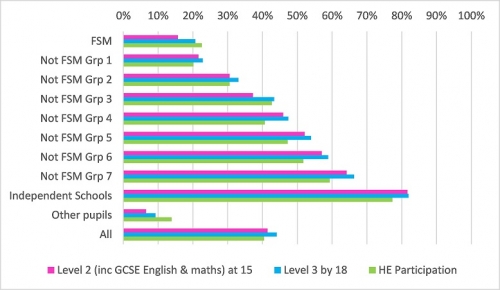
The profile of HE participation by socio-economic group can be contrasted with that of further education (Figure 2). Leaving aside the former pupils of independent schools, this is much more balanced. The most disadvantaged groups were in fact more likely to participate in FE than other groups; between the ages of 16-18, aged 19 and above, and for the total participating at any age from 16 upwards.
Figure 2: Percentage participating in further education by 2012/13 by socio-economic group at age 15
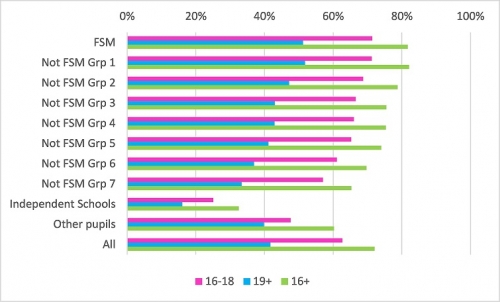
So it seems clear that disadvantaged groups are reached by the FE sector. Therefore it at least has the potential to improve social mobility. This has long been recognised, even by the then minister for further education and skills, John Hayes, in May 2011.
The government’s drive to create 3 million apprenticeships by 2020 may even be a positive step towards it.
But apprenticeships are unlikely to be suitable for everyone who is currently served by the FE sector. These might include pupils leaving schools with low levels of attainment, those wanting to reskill or retrain in response to changing circumstances or unemployment, or even those seeking routes to the sort of higher technician-level qualifications favoured by Alison Wolf.
It’s undoubtedly the case that the quality of some FE provision could be improved. It may even be poorly aligned with the demands of the economy. But we must recognise the potential of FE to improve social mobility rather than just see it as a fleshy budget that can be squeezed.
· for whom free school meals and/or postcode data was not available; or
· who were not on roll at state-funded schools at age 15. This includes pupils attending pupil referral units and other educational establishments that are not schools; or
· who were known to have previously been on roll at a state-funded school but were not at age 15 (this will include young people who may have emigrated or died).Data linkage errors notwithstanding, two-thirds of this group is subsequently observed to participate in education.

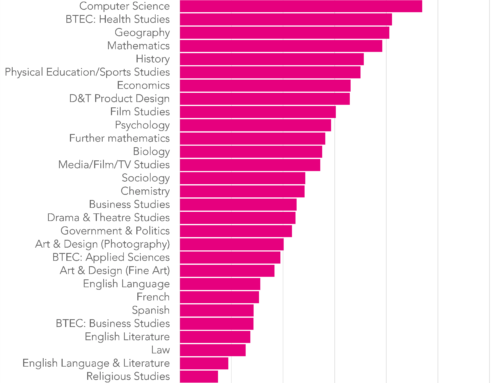

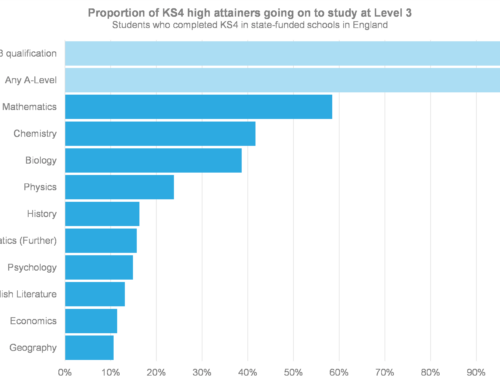
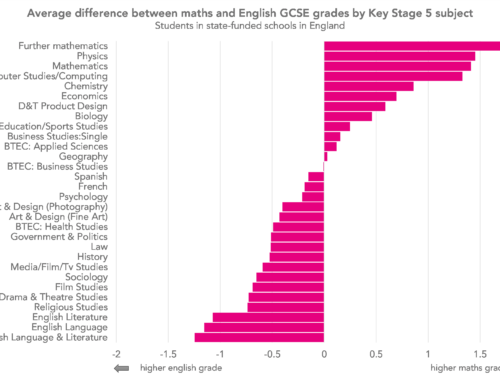
Hello Dave,
Thanks for this, it’s a very informative and clearly argued piece. Like you, I think FE does a great and unsung job in relation to social mobility. This forms a strand of a research project I am currently running with Vicky Duckworth. (http://transforminglives.web.ucu.org.uk/)
I was wondering if you could point me to a source for getting the numbers on average percentages of FSM background students who are studying in FE. Should come from ILR data as there is a code (FME2).
Interested to compare this with stats on FSM students in grammar schools (I think running at about 2.5%).
Regards
Rob
Thanks Rob. I’ve not seen any published data about FSM rates in FE colleges. You might be able to infer it from the EFA funding allocation data for 16-19 year olds- see https://www.gov.uk/government/publications/16-to-19-allocation-data-2016-to-2017-academic-year